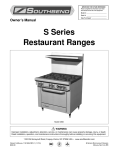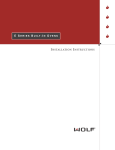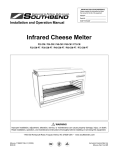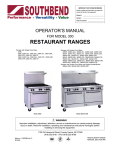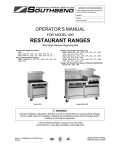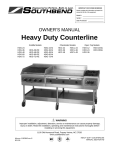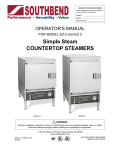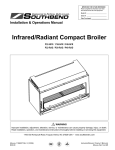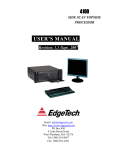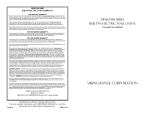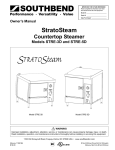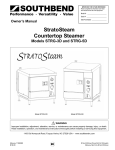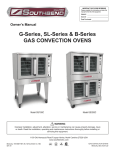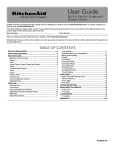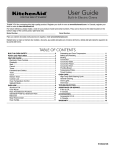Download Southbend S536D User's Manual
Transcript
IMPORTANT FOR FUTURE REFERENCE Please complete this information and retain this manual for the life of the equipment: Model #: __________________________ Serial #: __________________________ Date Purchased: ___________________ Owner’s Manual 500 Series Restaurant Ranges Models X536A, X536D, X560AA, X560AD, X560DD S536A, S536D, S560AA, S560AD, S560DD Model X536D Model X560DD WARNING This appliance shall be installed in conformity with the current regulations and used only in a well ventilated location. Consult the instructions before installing and using the appliance. Improper installation, adjustment, alteration, service, or maintenance can cause property damage, injury, or death. Read installation, operation, and maintenance instructions thoroughly before installing or servicing this equipment. 1100 Old Honeycutt Road, Fuquay-Varina, NC 27526 USA • www.southbendnc.com OWNER’S MANUAL 1188716 (02/07) $21.00 500 SERIES RESTAURANT RANGES MANUAL SECTION RR SAFETY PRECAUTIONS 500 SERIES RESTAURANT RANGES SAFETY PRECAUTIONS Before installing and operating this equipment, be sure everyone involved in its operation is fully trained and aware of precautions. Accidents and problems can be caused by failure to follow fundamental rules and precautions. The following symbols, found throughout this manual, alert you to potentially dangerous conditions to the operator, service personnel, or to the equipment. DANGER This symbol warns of immediate hazards that will result in severe injury or death. WARNING This symbol refers to a potential hazard or unsafe practice that could result in injury or death. CAUTION This symbol refers to a potential hazard or unsafe practice that could result in injury, product damage, or property damage. NOTICE This symbol refers to information that needs special attention or must be fully understood, even though not dangerous. WARNING FIRE HAZARD FOR YOUR SAFETY Do not store or use gasoline or other flammable vapors and liquids in the vicinity of cooking appliances. Keep area around cooking appliances free and clear of combustibles. Purchaser of equipment must post in a prominent location detailed instructions to be followed in the event the operator smells gas. Obtain the instructions from the local gas supplier. WARNING BURN HAZARD Contact with hot surfaces will cause severe burns. Always use caution when operating cooking appliances. WARNING EXPLOSION AND ASPHYXIATION HAZARD In the event a gas odor is detected, shut down equipment at the main gas shut-off valve and immediately call the emergency phone number of your gas supplier. Improper ventilation can result in headaches, drowsiness, nausea, and could result in death. Do not obstruct the flow of combustion and ventilation air to and from cooking appliances. WARNING ELECTRIC SHOCK HAZARD For appliances that use electric power, disconnect the power to the appliance before cleaning. Do not remove panels that require tools to remove. NOTICE This appliance is intended for commercial use, and is only for professional use. It shall be used by trained, qualified people. Warranty will be void if service work is performed by other than a qualified technician, or if other than genuine Southbend replacement parts are installed. Give this Owner’s Manual and important papers to the proper authority to retain for future reference. Copyright © 2007 by Southbend. All rights reserved. Published in the United States of America. PAGE 2 OF 44 OWNER’S MANUAL 1188716 (02/07) 500 SERIES RESTAURANT RANGES INTRODUCTION INTRODUCTION Congratulations! You have purchased one of the finest pieces of heavy-duty commercial cooking equipment on the market. You will find that your new equipment, like all Southbend equipment, has been designed and manufactured to meet the toughest standards in the industry. Each piece of Southbend equipment is carefully engineered and designs are verified through laboratory tests and field installations. With proper care and field maintenance, you will experience years of reliable, trouble-free operation. For best results, read this manual carefully. RETAIN THIS MANUAL FOR FUTURE REFERENCE. This manual is divided into six sections: Introduction ............................................3 Specifications.........................................4 Operation ...............................................8 Cleaning & Maintenance........................11 Installation..............................................13 Service...................................................19 The serial plate is located on the inside surface of the kick panel (see Figure 1 below). Read these instructions carefully before attempting installation. Installation and initial startup should be performed by a qualified installer. Unless the installation instructions for this product are followed by a qualified service technician (a person experienced in and knowledgeable with the installation of commercial gas and/or electric cooking equipment) then the terms and conditions on the Manufacturer’s Limited Warranty will be rendered void and no warranty of any kind shall apply. In the event you have questions concerning the installation, use, care, or service of the product, write to: Southbend 1100 Old Honeycutt Road Fuquay-Varina, North Carolina 27526 USA www.southbendnc.com Figure 1 Location of Serial Plate Serial Plate is Located on Inside Surface of Kick Panel OWNER’S MANUAL 1188716 (02/07) PAGE 3 OF 44 SPECIFICATIONS 500 SERIES RESTAURANT RANGES SPECIFICATIONS NOTICE Local codes regarding installation vary greatly from one area to another. The National Fire Protection Association, Inc., states in its NFPA 96 latest edition that local codes are the “authority having jurisdiction” when it comes to installation requirements for equipment. Therefore, installations should comply with all local codes. Southbend reserves the right to change specifications and product design without notice. Such revisions do not entitle the buyer to corresponding changes, additions, or replacements for previously purchased equipment. Southbend appliances are intended for commercial use only, not for household use. The installation must conform with local codes, or in the absence of local codes, with the National Fuel Gas Code, ANSI Z223.1, Natural Gas Installation Code, CAN/CGA-B149.1, or the Propane Installation Code CAN/CGAB149.2, as applicable, including: 1. The appliance and its individual shutoff valve must be disconnected from the gas supply piping system during any pressure testing of that system at test pressures in excess of 1/2 psi (3.45 kPa). 2. The appliance must be isolated from the gas supply piping system by closing its individual manual shutoff valve during any pressure testing of the gas supply piping system at test pressures equal to or less than 1/2 psi (3.45 kPa). CLEARANCES WARNING MINIMUM CLEARANCES FROM COMBUSTIBLE CONSTRUCTION There must be adequate clearance between ranges and combustible construction. Clearance must also be provided for servicing and for operation. Minimum Clearances: Sides Back Floor Standard Oven 10 inches 10 inches zero Convection Oven 10 inches 10 inches zero Double Oven Base 10 inches 10 inches zero Ranges are suitable for installation on combustible floors. Adequate clearance must be provided in the aisle and at the side and rear to allow the door to open sufficiently to permit the removal of the racks and for serviceability. On ranges with a convection-type oven, a minimum of 2 inches clearance must be allowed behind the motor and the rear non-combustible enclosure. Care must be taken to provide adequate air circulation to prevent the motor from overheating. No additional clearance from the sides and back is required for service as the ranges are serviceable from the front. DIMENSIONS The exterior dimensions of the restaurant range are shown in Figure 2 on the next page. PAGE 4 OF 44 OWNER’S MANUAL 1188716 (02/07) 500 SERIES RESTAURANT RANGES SPECIFICATIONS Figure 2 Dimensions O O Gas Connection R Electrical Connection Electrical Connections R Gas Connection R A A I I J J K K B B C G F F G E E Gas Connection Electrical Connection L L P Q N N M M D D Side View of Ranges WITH Convection Oven Side View of Ranges WITHOUT Convection Oven Exterior Dimensions in Inches and (Millimeters) Door Depth M Oven Bottom N A B C D E F G H I J K Cook Top Height L 536A 36.5" (927) 45.25" (1149) 10" (254) 31.25" (794) 33" (838) 11" (279) 2.75" (70) 59.5" (1511) 22.5" (587) 31.0" (787) 6" (152) 37.0" (914) 15.5" (394) 13" (318) 536D 36.5" (927) 36" (914) - 31.25" (794) 33" (838) 11" (279) 2.75" (70) 59.5" (1511) 22.5" (587) 31.0" (787) 6" (152) 37.0" (914) 15.5" (394) 13" (318) 560AA 560AD 60.75" (1543) 45.25" (1149) 10" (254) 31.25" (794) 33" (838) 11" (279) 2.75" (70) 59.5" (1511) 22.5" (587) 31.0" (787) 6" (152) 37.0" (914) 15.5" (394) 13" (318) 560DD 60.75" (1543) 36" (914) - 31.25" (794) 33" (838) 11" (279) 2.75" (70) 59.5" (1511) 22.5" (587) 31.0" (787) 6" (152) 37.0" (914) 15.5" (394) 13" (318) Model Number See table on next page for dimensions O, P, Q, and R. OWNER’S MANUAL 1188716 (02/07) PAGE 5 OF 44 SPECIFICATIONS 500 SERIES RESTAURANT RANGES INTERIOR DIMENSIONS AND UTILITY DATA Model Number Left (or Only) Oven Interior Dimensions Width Depth Height Right Oven Interior Dimensions Width Depth Height Burners (number of and BTU/hour) Open Oven Total BTU/hour Gas Connection Location O* P* Electric Connect. Location Q* R* X536A 26.125" (664) 24" (610) 14.25" (362) - - - 6@33,000 Nat 6@24,000 LP 1@32,000 Nat 1@30,000 LP 230,000 Nat 174,000 LP 3.25" (82) 30.25" (768) 24" (610) 6" (152) X536D 26" (660) 26.5" (673) 14" (356) - - - 6@33,000 Nat 6@24,000 LP 1@45,000 Nat 1@40,000 LP 243,000 Nat 184,000 LP 3.25" (82) 30.25" (768) - - X560AA 26.125" (664) 24" (610) 14.25" (362) 26.125" (664) 24" (610) 14.25" (362) 10@33,000 Nat 10@24,000 LP 2@32,000 Nat 2@30,000 LP 394,000 Nat 300,000 LP 3.25" (82) 30.25" (768) 24" (610) 6" (152) X560AD 26.125" (664) 24" (610) 14.25" (362) 26" (660) 26.5" (673) 14" (356) 10@33,000 Nat 10@24,000 LP 1@32,000 and 1@45,000 Nat 1@30,000 and 1@40,000 LP 407,000 Nat 310,000 LP 3.25" (82) 30.25" (768) 24" (610) 6" (152) X560DD 26" (660) 26.5" (673) 14" (356) 26" (660) 26.5" (673) 14" (356) 10@33,000 Nat 10@24,000 LP 2@45,000 Nat 2@40,000 LP 420,000 Nat 320,000 LP 3.25" (82) 30.25" (768) - - S536A 26.125" (664) 24" (610) 14.25" (362) - - - 6@27,000 Nat 6@21,000 LP 1@32,000 Nat 1@30,000 LP 194,000 Nat 156,000 LP 3.25" (82) 30.25" (768) 24" (610) 6" (152) S536D 26" (660) 26.5" (673) 14" (356) - - - 6@27,000 Nat 6@21,000 LP 1@45,000 Nat 1@40,000 LP 207,000 Nat 166,000 LP 3.25" (82) 30.25" (768) - - S560AA 26.125" (664) 24" (610) 14.25" (362) 26.125" (664) 24" (610) 14.25" (362) 10@27,000 Nat 10@21,000 LP 2@32,000 Nat 2@30,000 LP 334,000 Nat 270,000 LP 3.25" (82) 30.25" (768) 24" (610) 6" (152) S560AD 26.125" (664) 24" (610) 14.25" (362) 26" (660) 26.5" (673) 14" (356) 10@27,000 Nat 10@21,000 LP 1@32,000 and 1@45,000 Nat 1@30,000 and 1@40,000 LP 347,000 Nat 280,000 LP 3.25" (82) 30.25" (768) 24" (610) 6" (152) S560DD 26" (660) 26.5" (673) 14" (356) 26" (660) 26.5" (673) 14" (356) 10@27,000 Nat 10@21,000 LP 2@45,000 Nat 2@40,000 LP 360,000 Nat 290,000 LP 3.25" (82) 30.25" (768) - - * See figure on previous page for location of utility connections. VENTILATION WARNING Improper ventilation can result in personal injury or death. Ventilation which fails to properly remove flue products can cause headaches, drowsiness, nausea, or could result in death. All ranges must be installed in such a manner that the flow of combustion and ventilation air are not obstructed. Provisions for adequate air supply must be provided. Do not obstruct the front of the range at the top by the control panel, or the bottom just below the oven compartment, as combustion air enters through these areas. NOTICE Proper ventilation is the owner’s responsibility. Any problem due to improper ventilation will not be covered by the warranty. Be sure to inspect and clean the ventilation system according to the ventilation equipment manufacturer’s instructions. Canopies are set over ranges, ovens, etc., for ventilation purposes. It is recommended that a canopy extend 6" past the appliance and the bottom edge be located 78" above the floor. Filters should be installed at an angle of 45° or more from the horizontal. This position prevents dripping grease and facilitates collecting the run-off grease in a drip pan, unusually installed with a filter. A strong exhaust fan tends to create a vacuum in the room and may interfere with burner performance or may extinguish pilot flames. Fresh air openings approximately equal to the fan area will relieve such a vacuum. The exhaust fan should be installed at least 2" above the vent opening at the top of the range. If the range is connected directly to an outside flue, a CSA design-certified down draft diverter must be installed at the flue outlet of the oven and connected to the flue. PAGE 6 OF 44 OWNER’S MANUAL 1188716 (02/07) 500 SERIES RESTAURANT RANGES SPECIFICATIONS In case of unsatisfactory performance on any appliance, check the appliance with the exhaust fan in the OFF position. Do this only long enough to check equipment performance. Then turn hood back on and let it run to remove any exhaust that may have accumulated during the test. GAS SUPPLY A 3/4" female NPT gas connection is located on the rear of the range (see Figure 2). The serial plate is located on the right side of the range (See Figure 1). The serial plate indicates the type of gas the range is equipped to burn. All Southbend equipment is adjusted at the factory. Check type of gas on serial plate. These models are design-certified for operation on natural or propane gases. For natural gas, the regulator is set to 4" W.C. (0.99 kPa). For propane gas, it is set to 10" W.C. (2.48 kPa). If applicable, the vent line from the gas appliance pressure regulator shall be installed to the outdoors in accordance with local codes, or in the absence of local codes, with the applicable national codes. This appliance should be connected ONLY to the type of gas for which it is equipped. An adequate gas supply is imperative. Undersized or low pressure lines will restrict the volume of gas required for satisfactory performance. Fluctuations of more than 25% on natural gas or 10% on propane gas will create problems and affect burner operating characteristics. A 1/8" pressure tap is located on the manifold to measure the manifold pressure. An adequate gas supply line to the range should be no smaller than the inside diameter of the pipe from the range to which it is connected. Purge the supply line to clean out dust, dirt, or other foreign matter before connecting the line to the range. All pipe joints and connections must be tested thoroughly for gas leaks. Use only soapy water for testing on all gases. NEVER use an open flame to check for gas leaks. All connections must be checked for leaks after the range has been put into operation. Test pressure should not exceed 14" W.C. (3.47 kPa). ELECTRICAL REQUIREMENTS Ranges with a convection oven require connection to a supply of electricity. The appliance, when installed, must be electrically grounded in accordance with local codes, or in the absence of local codes, with the applicable national codes. An electrical diagram is located on the rear of the range, near the motor. Usually the range is furnished with one or two power cords (one for each oven), each with a standard 115V, 60Hz, single-phase prong plug. Total maximum power for 115V units is 4.8 amperes. The range can be ordered to operate on 208V 60Hz 1-phase or 3-phase current, in which case the electric power supply must be wired to one or two junction boxes (one for each oven), each with a terminal block on the rear of the range. Total maximum power for 208V units is 2.6 amperes. OWNER’S MANUAL 1188716 (02/07) PAGE 7 OF 44 OPERATION 500 SERIES RESTAURANT RANGES OPERATION DANGER EXPLOSION AND ASPHYXIATION HAZARD In the event a gas odor is detected, shut down equipment at the main gas shut-off valve and immediately call the emergency phone number of your gas supplier. Improper ventilation can result in headaches, drowsiness, nausea, and could result in death. Do not obstruct the flow of combustion and ventilation air to and from cooking appliances. CAUTION To eliminate gas build up which could result in an explosion, in the event of main burner ignition failure wait five minutes before attempting to relight the pilot or burner. The controls for the burners and oven(s) are located on the valve panel on the front of the range. If the pilots need to be lit, follow the steps listed in each section below. LIGHTING AFTER GAS HAS BEEN SHUT OFF When turning the main gas supply on after the gas supply has been shut off, do the following: 1. Make sure the gas supply valve, located on the front valve panel, is in the OFF position. 2. Make sure all of the control valves are in the OFF position. 3. Turn on the incoming gas supply. 4. Turn the gas supply valve, located on the front valve panel, to the ON position. 5. Light the pilots as described below. 6. Light the oven first and then wait six minutes before lighting top burners to purge all air from the range. OPERATION OF TOP BURNERS To operate a top burner, turn the corresponding control knob on the front panel to the desired flame level. Each top burner has its own pilot. If a top-burner pilot needs to be lighted, do the following: 1. Turn all the top-burner control knobs to the OFF position. 2. On S500 models, turn one of the top-burner control knobs to the pilot position, push the knob inward, and hold it in place. Depress and hold down the spark switch (the black button between the control valves). A spark from the ignitor to the pilot can be seen and heard. When the pilot lights, release the spark switch, but continue holding the knob in for 30 to 45 seconds. When the knob is released, the pilot should remain lit. On X500 models, depress and hold down the spark switch (the black button between the control valves). A spark from the ignitor to the pilot can be seen and heard. When the pilot lights, release the spark switch. 3. Repeat step 2 for the all other top-burner pilots that need to be lighted. OPERATION OF OVEN To operate an oven, turn the oven-thermostat knob on the front panel to the desired temperature. On convection ovens, the blower is controlled by an ON-OFF switch. Each oven has its own pilot. If an oven pilot needs to be lighted, do the following: 1. Turn the oven thermostat to the OFF position. 2. For convection ovens, turn the fan switch to the OFF position. 3. Open the oven door and remove the oven bottom and fire plate to expose pilot and burner. 4. Open the kick panel below the oven door and depress red button on oven safety valve. 5. Light constant pilot (the pilot without a capillary tube holder). 6. Close the kick panel and replace the fire plate and oven bottom. PAGE 8 OF 44 OWNER’S MANUAL 1188716 (02/07) 500 SERIES RESTAURANT RANGES OPERATION SHUTDOWN OF ENTIRE RANGE To completely shut down the range for an extended period (or prior to disconnecting the gas supply), do the following: 1. Turn all burner control knobs to OFF. 2. Turn the oven thermostat knob(s) to the lowest temperature. 3. Turn the main gas valve on the valve panel to OFF. 4. Turn-off the gas supply to the oven. TROUBLESHOOTING BY OPERATOR The following table lists the possible causes and solutions of problems that may occur during operation. Problem Possible Causes and Solutions A top burner will not light. – Check pilot position. – Check and light the burner’s pilot. – Check gas supply to range. Oven will not heat up. – Check and light the oven pilot. – Check gas supply to range. Blower of convection oven is not running. – Check that the oven’s blower control switch is in ON position. – Check electricity supply to range. Pilot(s) will not remain lit. – Check gas supply to range. – Check pilot adjustment. If other appliances connected to the same source of gas or electricity are also not operating correctly, the problem is likely not within the range. If the problem only occurs for the range, and if the above solutions to do not solve the problem, call for repair service. TROUBLESHOOTING CONVECTION-OVEN COOKING PROBLEMS If… then… Cakes are dark on the sides and not done in the center… lower oven temperature. Cake edges are too brown… reduce number of pans or lower oven temperature. Cakes have light outer color… raise temperature. Cake settles slightly in the center… bake longer or raise oven temperature slightly. Do not open doors too often for long periods. Pies have uneven color… reduce number of pies per rack. Meats are browned and not done in center… lower oven temperature and roast longer. Meats are well done and not browned… raise temperature. Limit amount of moisture. Cakes ripple… overloading pans or batter is too thin. There is excessive meat shrinkage… lower oven temperature. Cakes are too coarse… lower oven temperature. WARNING THE USE OF ALUMINUM FOIL CAN CAUSE HEAT DISTRIBUTION PROBLEMS IN OVENS. EXTREME CARE MUST BE USED WHEN PLACING ALUMINUM FOIL IN THE OVEN TO ENSURE THAT IT DOES NOT BLOCK OR CHANGE THE AIR FLOW. THE USE OF ALUMINUM FOIL MAY VOID THE PRODUCT WARRANTY IF ITS USE IS ASCERTAINED TO BE A PROBLEM. OWNER’S MANUAL 1188716 (02/07) PAGE 9 OF 44 OPERATION 500 SERIES RESTAURANT RANGES COOKING TIPS FOR CONVECTION OVENS As a guide, set oven temperatures 25 to 50 degrees lower than called for in recipes using conventional (nonconvection) ovens. FROZEN ENTREE PRODUCTS: Punch holes in lid before heating. Tent lid if product has a tendency to stick, i.e., lasagna or macaroni and cheese. Use manufacturer’s convection oven directions for time and temperature or reduce conventional oven temperature 50 degrees for a 6-1/2 size pan load. Some products may cook in 10 to 15 minutes less time than recommended for convection ovens if prepared from frozen in a 6 pan load. Time and temperatures will vary depending upon load, mix, size of portion, and other factors. Use the following chart to develop your own cooking techniques: Timing (minutes) Temperature Setting Number of Racks Used Count per Pan/Rack Hamburger buns, 3 oz. - 4" 18 375° 2 24 Yeast rolls - 1 oz. Use temperature and time recommended by manufacturer for convection ovens for a 3 pan load. 10 400° 2 48 Fruit pies, 46 oz. frozen Use temperature and time from manufacturer’s directions for convection ovens for a 12 pie load placed on 3 bun pans. 50 375° 2 4 Egg custard pies, 44 oz. frozen 60 325° 2 4 Dutch apple pies, 46 oz. frozen 50 350° 2 4 Baked potatoes, 8 oz. Wash and wrap in potato foil. Place 30 potatoes on 18 x 24 bun pan — 3 pans per load. Bake in 400°F oven for 1 hour. 60 400° 2 30 (wrapped) Pre-blanched potatoes, frozen Spread on ungreased bun pans, 3 pans per load. Bake at 400°F, stirring once, for 15 to 18 minutes. 16 400° 2 5 lb. Fish portions, pre-cooked, breaded, 3 oz. Use manufacturer’s recommended temperature and time for convection oven for a 3 pan load. 16 400° 2 32 Macaroni & cheese, 6 lbs. - 40° temp. 45 400° 2 2-6 lbs. Lasagna w/meat sauce, 6 lb. - 40° temp. 60 350° 2 2 - 6 lbs. Lasagna w/meat sauce, 6 lb. - frozen 75 350° 2 2-6 lbs. Salisbury steak w/gravy, 6 lb. - 40° temp. 45 400° 2 2-6 lbs. 14 lb. - rare 140° internal 14 min./lb. 250° 1 1-2 14 lb. - medium 150° internal 14 min./lb. 250° 1 1-2 14 lb. - well done 160° internal 14 min./lb. 250° 1 1-2 Product Top round of beef No. 168 PAGE 10 OF 44 OWNER’S MANUAL 1188716 (02/07) 500 SERIES RESTAURANT RANGES CLEANING & MAINTENANCE CLEANING & MAINTENANCE WARNING Shut off the range and allow time for it to cool before cleaning or performing maintenance. Southbend appliances are sturdily constructed of the best materials and are designed to provide durable service when treated with ordinary care. To expect the best performance, your equipment must be maintained in good condition and cleaned daily. Naturally, the periods for this care and cleaning depend on the amount and degree of usage. Following daily and periodic maintenance procedures will enhance long life for your equipment. Climatic conditions (such as salt air) may require more thorough and frequent cleaning or the life of the equipment could be adversely affected. Keep exposed, cleanable areas clean at all times. DAILY CLEANING 1. Turn all controls to OFF and allow time for the range to cool. 2. Remove, empty, and clean drip trays. 3. Wipe clean all cooking surfaces. CLEANING OVEN INTERIOR WARNING FOR YOUR SAFETY, BEFORE CLEANING A CONVECTION OVEN DISCONNECT THE POWER SUPPLY. WHEN CLEANING THE BLOWER WHEEL, BE SURE THAT THE POWER SWITCH IN THE “OFF” POSITION. Allow oven to cool. Remove porcelain enameled oven bottom. Clean by rubbing with strong detergent and Brillo pad or similar scrubber. “Spill-overs” should be cleaned from the bottom as soon as possible to prevent carbonizing and a “burnt-on” condition. For stubborn accumulations, commercial oven cleaners are recommended. The porcelain oven door lining can be cleaned in a similar manner. The side, rear and top lining should be wiped only with a cloth dampened with a mild detergent and water. Avoid using excessive amounts of water, as this may drip into burner compartment and deteriorate the metal in that area. Do not use strong commercial cleaners or abrasive pads on the side, rear or top linings, as they may damage the finish or leave gray residue. PERIODIC CLEANING AND MAINTENANCE At least monthly, clean around burner air mixers and orifices if lint has accumulated and visually check proper pilot operation. At least twice a year, examine and clean the range hood and venting system. If range-top spillage should occur, it may be necessary to clean around pilot areas, air mixer, and under burners. Use a wire brush if necessary. If any burners become clogged, remove and clean them. Allow interior to drain. Dry thoroughly before replacing. BLUE BAKED-ENAMEL SURFACES Wash exterior blue baked-enamel surfaces with a hot, mild detergent or soap solution to clean off all grease deposits. Dry thoroughly with a dry cloth. OWNER’S MANUAL 1188716 (02/07) PAGE 11 OF 44 CLEANING & MAINTENANCE 500 SERIES RESTAURANT RANGES STAINLESS-STEEL SURFACES To remove normal dirt, grease and product residue from stainless steel surfaces that operate at LOW temperature, use ordinary soap and water (with or without detergent) applied with a sponge or cloth. Dry thoroughly with a clean cloth. To remove BAKED-ON grease and food splatter, or condensed vapors; apply cleanser to a damp cloth or sponge and rub cleanser on the metal in the direction of the polishing lines on the metal. Rubbing cleanser, as gently as possible, in the direction of the polished lines will not mar the finish of the stainless steel. NEVER RUB WITH A CIRCULAR MOTION. Soil and burnt deposits which do not respond to the above procedure can usually be removed by rubbing the surface with SCOTCH-BRITE scouring pads or STAINLESS scouring pads. DO NOT USE ORDINARY STEEL WOOL as any particles left on the surface will rust and further spoil the appearance of the finish. NEVER USE A WIRE BRUSH, STEEL SCOURING PADS (EXCEPT STAINLESS), SCRAPER, FILE OR OTHER STEEL TOOLS. Surfaces which are marred collect dirt more rapidly and become more difficult to clean. Marring also increases the possibility of corrosive attack. Refinishing may then be required. “Heat tint” is darkened areas that sometimes appear on stainless steel surfaces where the area has been subjected to excessive heat. These darkened areas are caused by thickening of the protective surface of the stainless steel and are not harmful. Heat tint can normally be removed by the foregoing, but tint which does not respond to this procedure calls for a vigorous scouring in the direction of the polish lines using SCOTCH-BRITE scouring pads or a STAINLESS scouring pad in combination with a powered cleanser. Heat tint may be lessened by reducing heat to equipment during slack periods. BRIGHT-ANNEALED STAINLESS-STEEL SURFACES To remove normal dirt, grease and product residue from stainless steel surfaces that operate at LOW temperature, use ordinary soap and water (with or without detergent) applied with a sponge or cloth. Dry thoroughly with a clean cloth. Never use any abrasive cleaner, pad, wire brush, scrapper, or file to remove material from the bright-annealed surfaces. PAGE 12 OF 44 OWNER’S MANUAL 1188716 (02/07) 500 SERIES RESTAURANT RANGES INSTALLATION INSTALLATION NOTICE These installation procedures must be followed by qualified personnel or warranty will be void. Local codes regarding installation vary greatly from one area to another. The National Fire Protection Association, Inc., states in its NFPA 96 latest edition that local codes are the “authority having jurisdiction” when it comes to installation requirements for equipment. Therefore, installations should comply with all local codes. The installation must conform with local codes, or in the absence of local codes, with the National Fuel Gas Code, ANSI Z223.1, Natural Gas Installation Code, CAN/CGA-B149.1, or the Propane Installation Code CAN/CGAB149.2, as applicable, including: 1. The appliance and its individual shutoff valve must be disconnected from the gas supply piping system during any pressure testing of that system at test pressures in excess of 1/2 psi (3.45 kPa). 2. The appliance must be isolated from the gas supply piping system by closing its individual manual shutoff valve during any pressure testing of the gas supply piping system at test pressures equal to or less than 1/2 psi (3.45 kPa). NOTICE EXHAUST FANS AND CANOPIES: It is recommended that the range be installed under a ventilation hood. Consult local codes for proper installation of hoods. Proper ventilation is the owner’s responsibility. Any problem due to improper ventilation will not be covered by warranty. NOTICE In the Commonwealth of Massachusetts all gas appliances vented by either mechanical systems or ventilation hoods shall comply with 248 CMR interlocking requirements. STEP 1: UNPACKING IMMEDIATELY INSPECT FOR SHIPPING DAMAGE All containers should be examined for damage before and during unloading. The freight carrier has assumed responsibility for its safe transit and delivery. If damaged equipment is received, either apparent or concealed, a claim must be made with the delivering carrier. Apparent damage or loss must be noted on the freight bill at the time of delivery. The freight bill must then be signed by the carrier representative (Driver). If the bill is not signed, the carrier may refuse the claim. The carrier can supply the necessary forms. A request for inspection must be made to the carrier within 15 days if there is concealed damage or loss that is not apparent until after the equipment is uncrated. The carrier should arrange an inspection. Be certain to hold all contents plus all packing material. Do the following: 1. Cut the banding straps and remove the corrugated cardboard surrounding the range. If legs were shipped in the same container, set them aside for installation in later steps of this procedure. Do not remove any tags or labels attached to the range until the range is installed and working properly. 2. Lift the flue riser off the front of the skid (see Figure 3) and set it aside for installation later in this procedure. 3. Pull the shelf assembly out from under the base and set it aside for installation later in this procedure. 4. Unbolt the shipping hold-down brackets from the skid, then remove the brackets from the range. 5. If the range is to be installed on legs, go to Step 2a. If the range is to be installed on casters, go to Step 2b. OWNER’S MANUAL 1188716 (02/07) PAGE 13 OF 44 INSTALLATION 500 SERIES RESTAURANT RANGES Figure 3 Unpacking Base Flue Riser Shelf Skid STEP 2A: ATTACH LEGS A set of four legs is packed with ranges ordered with legs. (For ranges ordered with casters, go to Step 2b.) A threaded leg pad is fastened to the base frame at each corner. Each leg has a corresponding mating thread. The legs can be adjusted to overcome a slightly uneven floor. 1. Raise range sufficiently to allow leg pads and legs to be attached. For safety, “shore up” and support the range with an adequate blocking arrangement strong enough to support the load. 2. Attach the four leg pads to the bottom of the range using the lock washers and machine screws. The mounting holes are pre-drilled and threaded. 3. Screw the legs into the holes in the centers of the leg pads. 4. Lower range gently onto a level surface. Never drop or allow the range to fall. 5. Use a level to make sure that the range surface is level. The legs can be screwed in or out to lower or raise each corner of the range. 6. Go on to Installation Step 3. Figure 4 Installation of Legs PAGE 14 OF 44 OWNER’S MANUAL 1188716 (02/07) 500 SERIES RESTAURANT RANGES INSTALLATION STEP 2B: ATTACH CASTERS AND RESTRAINT NOTICE For an appliance equipped with casters, (1) the installation shall be made with a connector that complies with the Standard for Connectors for Movable Gas Appliances, ANSI Z21.69 or Connectors for Moveable Gas Appliances, CAN/CGA-6.16, and a quick-disconnect device that complies with the Standard for QuickDisconnect Devices for Use With Gas Fuel, ANSI Z21.41, or Quick Disconnect Devices for Use with Gas Fuel, CAN1-6.9, (2) adequate means must be provided to limit the movement of the appliance without depending on the connector and the quick-disconnect device or its associated piping to limit the appliance movement, and (3) the restraining means should be attached to a frame member on the back of the unit. A set of four casters is packed with ranges ordered with casters (instead of legs). A threaded leg pad is fastened to the base frame at each corner. Each caster has a corresponding mating thread. The casters can be adjusted to overcome a slightly uneven floor. Casters are provided with a Zerk fitting for proper lubrication when required. 1. Raise range sufficiently to allow leg pads and casters to be attached. For safety, “shore up” and support the range with an adequate blocking arrangement strong enough to support the load. 2. Attach the four leg pads to the bottom of the range using the lock washers and machine screws. The mounting holes are pre-drilled and threaded. 3. Screw the casters into the holes in the centers of the leg pads. Install the casters that have a locking brake under the front of the range. 4. Lower range gently onto a level surface. Never drop or allow the range to fall. 5. Use a level to make sure that the range surface is level. The casters can be screwed in or out to lower or raise each corner of the range. After the range has been leveled, tighten the lock nuts. Figure 5 Installation of Casters 6. Secure the restraining-device bracket (item “B” in the following illustration) to a wall stud located as close as possible to the appliance connector inlet and outlet connections. Use four #12 screws (items “C”) and plastic anchors (items “A”) if necessary. 7. Install eye-bolt (item “F”) to a frame member on the rear of the equipment. After checking carefully behind the frame member for adequate clearance, drill a 7 mm hole through the frame member. 8. Thread hex nut (item “G”) and slide the washer (item “H”) onto the eye-bolt. Insert the eye-bolt through the 7 mm drilled hole and secure with a washer (item “H”) and nylon lock nut (item “I”). 9. Using the spring-loaded snap hooks, attach the restraining device to the bracket and the eye-bolt. OWNER’S MANUAL 1188716 (02/07) PAGE 15 OF 44 INSTALLATION 500 SERIES RESTAURANT RANGES 10. Using the cable clamp (item “D”), adjust the restraining device extended length to prevent over-bending or kinking of the appliance connector. Figure 6 Installation of Restraint A D E F H C B G I Be sure all controls are turned off prior to disconnecting. After reconnecting, be sure all controls are turned off and all pilots are lit. NOTICE Adequate means must be provided to limit the movement of the appliance without depending on the connector and the quick-disconnect device or its associated piping to limit the appliance movement. The restraining means should be attached to a frame member on the back of the range. PAGE 16 OF 44 OWNER’S MANUAL 1188716 (02/07) 500 SERIES RESTAURANT RANGES INSTALLATION STEP 3: ATTACH FLUE RISER AND SHELF ASSEMBLY Place the flue riser assembly on the range as shown on the appropriate diagram below. 1. Slide the flue riser assembly over the bayonets until it bottoms out, as shown below. 2. Secure ends of flue riser assembly with two (2) 1/4-20 x 3/4 hex head bolts, flat washers and lockwashers 3. Attach the shelf assembly to the flue riser assembly. Figure 7 Installation of Flue Riser and Shelf Assembly Single-Oven Models Dual-Oven Models STEP 4: ELECTRICAL CONNECTION (FOR CONVECTION-OVEN MODELS ONLY) Wiring diagrams are located on the rear of the range. Be sure that the input voltage and phase match the requirements shown on the serial plate (see Figure 1 on page 3). Ranges are factory-equipped either with a power cord or with one or two two-pole terminal blocks (one for each oven), located behind cover plate(s) located on the rear of the range. To connect the supply wires, remove the appropriate cover plate. Route the supply wires and the grounding wire through the strain relief fitting to the terminal block. Insert the supply wires, one each, into the two poles of the terminal block and tighten the screws. Insert the ground wire into the grounding lug and tighten the screw. Re-attach the cover plate. Three phase ranges are wired as above, using only two supply wires. The third wire is not used and must be properly terminated. All ranges are shipped wired as specified by factory order. Conversion between single-phase and three-phase can be accomplished by referring to phase loading and line amperes chart on wiring diagram for wire size and ampere requirements. STEP 5: GAS CONNECTION If this equipment is being installed at over 610 meters altitude and that information was not specified when ordered, contact the appropriate authorized Southbend Service Representative or the Southbend Service Department. Failure to install with proper orifice sizing will result in poor performance and may void the warranty. The serial plate is located on the interior side of the kick panel below the oven. It indicates the type of gas the range is equipped to burn. All Southbend equipment is adjusted at the factory. Check type of gas on serial plate. OWNER’S MANUAL 1188716 (02/07) PAGE 17 OF 44 INSTALLATION 500 SERIES RESTAURANT RANGES These models are design-certified for operation on natural or propane gases. For natural gas, the regulator is set to deliver gas at 0.99 kPa (4" W.C.) pressure to the manifold. For propane gas, it is set to 2.48 kPa (10" W.C.). This appliance should be connected ONLY to the type of gas for which it is equipped. An adequate gas supply is imperative. Undersized or low pressure lines will restrict the volume of gas required for satisfactory performance. Fluctuations of more than 25% on natural gas or 10% on propane gas will create problems and affect burner operating characteristics. A 1/8" pressure tap is located on the manifold to measure the manifold pressure. The gas supply line to the range should be no smaller than the inside diameter of the pipes to which it is connected. Purge the supply line to clean out dust, dirt, or other foreign matter before connecting the line to the range. CAUTION ALL PIPE JOINTS AND CONNECTIONS MUST BE TESTED THOROUGHLY FOR GAS LEAKS. USE ONLY SOAPY WATER FOR TESTING ON ALL GASES. NEVER USE AN OPEN FLAME TO CHECK FOR GAS LEAKS. ALL CONNECTIONS MUST BE CHECKED FOR LEAKS AFTER THE RANGE HAS BEEN PUT INTO OPERATION. TEST PRESSURE SHOULD NOT EXCEED 14" W.C. (3.47 kPa). STEP 6: CHECK THE INSTALLATION Check the installation of the range, as follows: 1. Check that all screws and bolts are tightened. 2. Check that the electrical and gas connections have been made correctly. 3. With the range in the position that it will be operated, check that the range is level. If not, adjust the legs or casters. 4. Check that the appropriate minimum clearances are satisfied (see page 4). 5. Check that the oven door(s) open and close properly. 6. Check that there is sufficient clearance in front of the range to open the oven door. 7. Wipe clean all surfaces. STEP 7: CHECK OPERATION Check the operation of the range, as follows: 1. Turn on the gas supply and, for convection-oven models, the electric power supply. 2. Light the burner pilots and oven pilot(s), starting with the top burner farthest from the gas input in order to purge the system of air. Check for proper pilot-flame height and adjust pilots, if necessary. 3. Turn on the oven and all burners at the same time. Check for correct burner operation and adjust the air shutters, if necessary. 4. On convection-oven models, turn on the blower(s) and check for proper operation. 5. Turn off the burners and oven. STEP 8: SHUT-DOWN AND WIPE-CLEAN RANGE Complete the installation by leaving the range ready for customer use: 1. Allow the range to cool. 2. Wipe clean all surfaces. 3. Unless the range is to be placed in service immediately, turn off the gas supply and (for convection-oven models, the electricity supply. 4. Make sure that a copy of this manual will be available to the people who will operate and maintain the range. PAGE 18 OF 44 OWNER’S MANUAL 1188716 (02/07) 500 SERIES RESTAURANT RANGES SERVICE SERVICE WARNING ADJUSTMENTS AND SERVICE WORK MAY BE PERFORMED ONLY BY A QUALIFIED TECHNICIAN WHO IS EXPERIENCED IN, AND KNOWLEDGEABLE WITH, THE OPERATION OF COMMERCIAL COOKING EQUIPMENT. TO ASSURE YOUR CONFIDENCE, CONTACT YOUR AUTHORIZED SERVICE AGENCY FOR RELIABLE SERVICE, DEPENDABLE ADVICE OR OTHER ASSISTANCE, AND FOR GENUINE FACTORY PARTS. NOTICE INSTALLATION OF OTHER THAN GENUINE SOUTHBEND PARTS WILL VOID THE WARRANTY ON THIS EQUIPMENT. The serial plate are located on the right side of the range (see Figure 1 on page 3). Replacement parts (including parts not listed in this manual) may be ordered either through a Southbend Authorized Parts Distributor or a Southbend Authorized Service Agency. When ordering parts, please supply the Model Number, Serial Number, Part Number, and Part Description. In case of problems in operation at initial installation, check type of gas and manifold pressure and compare with information listed on the serial plate. This section contains troubleshooting flowcharts, procedures, and electric schematics to assist a qualified service technician in the servicing of a Southbend Model S500 Restaurant Range. TROUBLESHOOTING FLOWCHARTS, PROCEDURES, AND WIRING DIAGRAMS Find the symptom below that corresponds to the malfunction, then turn to the corresponding page. Follow the flowchart on that page until the problem is solved. Troubleshooting Flowchart, Procedure, or Wiring Diagram Page Troubleshooting Open-Top Burners 20 Troubleshooting Base Oven 21 Troubleshooting Convection-Oven Blower 22 Adjustment of Gas Pressure Regulator 24 Adjustment of Open-Top Pilots 25 Adjustment of Open-Top Burners 25 Adjustment of Oven Standing Pilot 25 Adjustment of Oven Burner 25 Adjustment of Oven Bypass Flame Level 25 Calibration of Oven Thermostat 26 Conversion from One Type of Gas to Another 27 Wiring Diagram for 115 Volt Models 28 Wiring Diagram for 208-230 Volt Models 29 OWNER’S MANUAL 1188716 (02/07) PAGE 19 OF 44 SERVICE 500 SERIES RESTAURANT RANGES TROUBLESHOOTING OPEN-TOP BURNERS Each open-top burner should have a steady blue flame on each port of the burner. Propane burners may have a small amount of yellow tipping, and may make a slight popping noise when turned off. If the flame is rising up off of the ports, adjust the burner shutter so it is more closed. If the flame is long and yellow adjust the burner shutter so it is more open. Consult the following table and the flowchart on this page. Problem Look for - No burners or pilots in the range will turn on. – Main gas supply to range is OFF. All burners produce excessive carbon deposits. – Incorrect gas type supplied to range. – Incorrect supply pressure. Only some burners in a range produce excessive carbon deposits. – Incorrect orifices. – Primary air not adjusted properly. Only some pilots produce excessive carbon deposits. – Pilot gas not adjusted properly. – Incorrect pilot orifice. Top burner will not come on, but oven will come on. – Control valve for top burner is in OFF position. – Pilot out. Open-top burner pilot will not stay ignited. – Pilot gas not adjusted properly. – Clogged orifice. – Draft condition. – Improper ventilation system. – Air in gas line. – Thermocouple bad. Figure 8 Troubleshooting Open-Top Burners Open-top burners are not working correctly. Check that the burners are set level in their support brackets. Check that the burners are clean and that their ports are clear. Remove each burner and check that the venturi is clean and free of buildup and debris. Also check that the orifice size is correct and that it is clean and free of buildup and debris. Remove the burner control knobs and carefully lower the valve panel. CAUTION! Convection oven models have wiring attached behind the panel. Check that each burner valve and orifice is in alignment with the corresponding burner. Check the pressure of the gas supply with all the gas appliances connected to the supply turned fully on. The inlet pressure (before entering the pressure regulator for the range) must be in the range 3.5" to 5" W.C. (0.87 to 1.24 kPa) for natural gas, or in the range 10" to 11" W.C. (2.48 to 2.73 kPa) for propane. Adjust the pressure and/or capacity of the gas supply, if necessary. Check the pressure of the gas manifold of the range (after the gas leaves the pressure regulator for the range). See page 25. PAGE 20 OF 44 OWNER’S MANUAL 1188716 (02/07) 500 SERIES RESTAURANT RANGES SERVICE TROUBLESHOOTING BASE OVEN CAUTION Proper and efficient operation of oven is dependent on correct installation and function of components. Always verify that components are in place and functioning as intended. Consult the following table and the flowchart that begins on the following page. Problem Look for - Oven will not come on. – Oven pilot is out. Oven pilot will not stay ignited – Pilot gas not adjusted properly. – Bad thermocouple. – Bad thermocouple connections at safety valve. – Bad safety. – Clogged orifice. – Draft condition. – Improper ventilation system. – Air in gas line. Figure 9 Troubleshooting Oven Pilot Oven pilot does not work. Check whether the pilot flame is lit by looking through the hole in the bottom of the oven. Leave the oven door open for five minutes to allow gas fumes to clear. If the pilot is not lit, attempt to light the pilot by raising the kick panel slightly and rotating its top edge outward. Press and hold the red button on the oven safety valve and put a flame to the pilot. No Does the pilot light? Check that the oven pilot adjustment on the manifold is open. If the pilot still will not light, do the following: Remove the oven bottom. Loosen the pilot nut on the burner bracket. Remove the pilot tube from the safety valve. Remove the pilot orifice from the pilot or end of the tube and check for debris. Re-install the pilot orifice and tubing. OWNER’S MANUAL 1188716 (02/07) Yes Continue to hold the red button for 30 seconds. The pilot should remain lit after the button is released. If it does not, wait five minutes and try again. If the pilot will not remain lit, do the following: Remove the thermocouple from the safety valve. Install a thermocouple adapter between the safety valve and the thermocouple to measure the direct-current millivoltage produced by the thermocouple. While holding the red button, light the pilot and measure the voltage produced by the thermocouple. If the voltage does not rise above 10 millivolts, adjust the pilot valve and retest. If the voltage still does not quickly rise above 10 millivolts, replace the thermocouple. If instead the thermocouple is working properly, replace the safety valve. PAGE 21 OF 44 SERVICE 500 SERIES RESTAURANT RANGES TROUBLESHOOTING CONVECTION-OVEN BLOWER WARNING Before attempting to service or replace any electrical component, make sure power source has been disconnected. CAUTION When changing motor or servicing range, always verify that blower wheel rotation is clockwise when looking into the oven cavity. The motor is serviceable from the front of the range through the oven cavity. Remove the back lining. Disconnect the motor mount plate by removing the eight hex nuts that secure it to the oven interior back. Pull the mount plate, with motor attached, into the oven. Motor lubrication information can be found on permanent label located on motor. If the blower does not run at all, consult the flowchart that begins on the next page. If the blower runs intermittently, consult the flowchart on this page. The appropriate wiring diagram for the oven can be found on the rear of the oven (as well as at the end of this section of this manual). Figure 10 Convection-Oven Blower Runs Intermittently Convection-oven blower runs intermittently. No Does the problem occur only when the oven is hot? Yes DISCONNECT POWER AT CIRCUIT BREAKER. Check that there are no air-flow obstructions around the range. Check all wiring for loose connections or breaks. Check that the blower motor is not pressing against the wall behind the range. Remove the cover from the junction box on the back of the range. Disconnect the black wire and place an ammeter in the circuit. CAUTION: Check that the ammeter is rated for at least 40 amperes! Reconnect the power to the range and turn on the blower switch while watching the ammeter. The reading should surge and then return to the rated current of the motor when running at high speed. If the measured current exceeds the motor rating, replace the blower motor. Check that the blower motor air vents are not obstructed. Check for excessive grease and dust buildup on the motor. Check for sources of excessive heat behind the range. Check for hot-air leaks around the motor pocket. With the blower turned ON, turn the oven thermostat to OFF and allow the oven to cool. If the blower motor runs continuously when the oven is cool, turn the oven thermostat to the highest setting. If the blower motor shuts off when the oven becomes hot, and if there are no sources of excessive heat around the blower motor, replace the blower motor. PAGE 22 OF 44 OWNER’S MANUAL 1188716 (02/07) 500 SERIES RESTAURANT RANGES SERVICE Figure 11 Convection-Oven Blower Does Not Run Convection-oven blower does not run. DISCONNECT POWER AT CIRCUIT BREAKER. Remove the control knobs from the front of the range. Remove the screws that secure the top of the valve panel and carefully tilt the panel forward to expose the back of the blower switch that is mounted in the front panel. CAUTION: Be careful not to damage the wiring behind the control panel. Remove the protective cover from the blower control switch. Check that the switch wires and terminals are secure. Use a multimeter to check the continuity across the terminals of blower-switch wires 1 and 3 (refer to the appropriate wiring diagram in this manual or on the range). With the switch in the ON position, there should be continuity. Is there continuity? No Replace the blower control switch. Yes Reconnect the power supply. Use a voltmeter to measure the voltage across the center terminals of switch wires 1 and 2. Yes Does the measured voltage match the rated voltage of the range? Re-assemble the switch cover and valve panel. Turn on the blowercontrol switch and open the oven door. No Does the blower run with the oven door open? No Check power supply to range. Yes DISCONNECT POWER AT CIRCUIT BREAKER. DISCONNECT POWER AT CIRCUIT BREAKER. Open the kick panel below the oven door by raising it slightly and tilting the top edge outward. Locate the door switch and check for continuity across the wired switch terminals while pressing the switch actuator lever. Open the kick panel below the oven door by raising it slightly and tilting the top edge outward. Locate the door switch and check that one wire is connected to the common (90° bottom) terminal of the switch. Move the other wire to the normally open (lower leg) terminal on the side of the door switch. No Is there continuity? Replace door switch. Yes Close the oven door (which should press the door-switch actuator lever). No Is there continuity? Yes Continue on next page. Loosen the two screws on the door switch bracket and adjust it so that the door switch is pressed when the oven door is closed. OWNER’S MANUAL 1188716 (02/07) PAGE 23 OF 44 SERVICE 500 SERIES RESTAURANT RANGES Figure 12 Convection-Oven Blower Does Not Run, Continued (Continuing from previous page.) CHECK THAT POWER IS DISCONNECTED AT CIRCUIT BREAKER. Remove the wire terminal cover from the blower motor. Check that the red wire is capped off. Remove the wire nuts from the black and the white wires. Check that in each case the wires are twisted together securely. Check that the common wire is connected to the motor black wire. Check that the neutral wire is connected to the white wire. Reconnect the power supply and turn on blower-control switch. Use a voltmeter to measure the voltage between the black wire and the white wire. No Is there voltage? Yes DISCONNECT POWER AT CIRCUIT BREAKER. DISCONNECT POWER AT CIRCUIT BREAKER. Check all wiring for loose terminals or breaks. Remove the wire nuts from the red, white, and black wires. Check that the resistance across the white and black wires is approximately 1.9 ohms. Check that the resistance across the white and red wires is also approximately 1.9 ohms. If either resistance is incorrect, replace the blower motor. ADJUSTMENT OF GAS PRESSURE REGULATOR The pressure regulator is factory set at 4" W.C. (0.99 kPa) for natural gas and 10" W.C. (2.48 kPa) for propane gas. To check the manifold pressure: 1. Turn all thermostats and burner valves to OFF position. 2. Turn main gas valve to entire range off. 3. Remove valve panels and locate the small plug in the manifold. 4. Remove plug and install a fitting appropriate to connect a manometer. 5. Turn on main gas to range and light pilots. 6. Turn all burners and ovens to full ON position and read manometer. 7. If manometer does not read 4" W.C. (0.99 kPa) for natural gas, or 10" W.C. (2.48 kPa) for propane gas, adjust regulator (if gas pressure is correct go to Step 10). 8. Remove cap from top of regulator. 9. With a screwdriver rotate regulator adjustment screw clockwise to increase, or counterclockwise to decrease, pressure until manometer shows correct reading. 10. Repeat steps 1 and 2. 11. Remove manometer fitting and replace plug in manifold. 12. Turn on main gas to range and light pilots. 13. Replace valve panels. PAGE 24 OF 44 OWNER’S MANUAL 1188716 (02/07) 500 SERIES RESTAURANT RANGES SERVICE ADJUSTMENT OF OPEN-TOP PILOTS The open-top pilots are the non-aerated (yellow-tipped flame) type. One is located beside each open-top burner. Pilot outage is often caused by an unstable flame due to over-adjustment to the point where the flame is leaving its port, or “blowing off.” Often, in an effort to improve ignition, the pilots are increased too much and result in this unstable condition. The pilots are adjusted by inserting the blade of a screwdriver into the slot on the small valve, located on the manifold. The maximum flame size is approximately 19 mm with a slight yellow tip. The first indication of over-adjustment is evident when the yellow tip begins to stream into black streaks and generate carbon. Continued over-adjustment leads to the unstable lifting and blowing condition. ADJUSTMENT OF OPEN-TOP BURNERS All open-top burners are primarily adjusted by means of an air shutter on the mixer face. To adjust a burner, loosen the screw that holds the air shutter in position and rotate the mixer cap until a clear, stable blue flame is obtained. The flame should not be yellow tipped nor should it blow off the burner ports. All orifice sizes and burner rate are properly set at the factory and should not be altered. Over-rated burners cause poor burner and pilot performance, resulting in less heat, and wasted gas. ADJUSTMENT OF OVEN STANDING PILOT The standing oven pilot flame can be adjusted by turning the adjusting screw on the pilot line valve with a screwdriver. The pilot line valve is located behind the kick panel below the oven door. Remove the kick panel to gain access. The pilot flame is properly adjusted when it is just large enough to maintain a glowing red color of the flame switch capillary bulb. ADJUSTMENT OF OVEN BURNER The oven burner orifice is of the fixed type, sized for the specified gas supply. The burner flame characteristics are controlled by varying the primary air mixer cap. There should be a clear blue flame with a distinct inner cone at each port. Excessive primary air can result in “blowing” or the flames leaving the ports. Lack of primary air causes soft or yellow tipped flame. ADJUSTMENT OF OVEN BYPASS FLAME LEVEL When the oven reaches the temperature at which the dial is set, the oven thermostat reduces the flow of gas to the amount required to keep the oven at that temperature. However, the thermostat must always supply enough gas to keep the entire burner lighted. To maintain this minimum flame, the bypass must be set carefully and accurately using the following procedure (see illustration on page 27): 1. Open the kick panel below the door of the oven by lifting it slightly and pulling the top edge away from the oven. The oven burner should now be visible. 2. Turn the oven thermostat to its highest setting and check that the oven burner ignites. 3. After 5 minutes, turn the oven thermostat down to point between the two lines on the thermostat dial between OFF and the lowest temperature setting (this is the bypass setting). 4. Check to see if the flame is about 1/4 inch (6 mm) high along the entire length of the burner. If it is, the bypass flame level does not need adjustment. If it is not, continue with this procedure. 5. Remove the control knobs, thermostat dial and bezel, and the valve panel. 6. Using a screwdriver, turn the bypass adjustor on the stem of the thermostat (see illustration on page 27) counterclockwise to increase the flame or clockwise to decrease the flame until the flame is approximately 6 mm (1/4 inch) high along the entire length of the burner. (If no flame is present at all, place a flame at the burner shutter to check for gas flow.) If the proper flame level cannot be established, replace the thermostat. 7. Replace the valve panel, control knobs, and thermostat bezel and dial. Turn all control knobs to the OFF position. OWNER’S MANUAL 1188716 (02/07) PAGE 25 OF 44 SERVICE 500 SERIES RESTAURANT RANGES CALIBRATION OF OVEN THERMOSTAT The oven thermostat control is carefully calibrated at the factory so that its dial settings closely match actual oven temperatures. Field recalibration is seldom necessary, and should not be resorted to unless considerable experience with unexpected cooking results definitely proves that the control is not maintaining the temperatures to which the dial is set. Do not recalibrate the oven thermostat until after the oven bypass flame has been adjusted (see previous procedure). When checking the oven temperature, use a test instrument or a reliable mercury thermometer positioned in the center of the oven. The oven bottom must be in place. For convection ovens, the blower baffle must be in place. Proceed as follows: 1. Place the thermometer or the thermocouple of the test instrument on an oven rack in the center of the oven. 2. Remove the thermostat knob and push out its metal insert (see Figure 13 on page 27). 3. Replace the thermostat knob and turn it to the 400°F (200°C) mark. Check that the oven burner comes on. 4. After oven burner has been on about 15 minutes, check the oven temperature. Open the oven door for as short a time as possible. Use a flashlight, if necessary, to see the thermometer or test instrument clearly. 5. Continue to check the temperature at five-minute intervals until two successive readings are within 5°F (3°C) of each other. If successive readings continue to vary too much, first check the bypass-flame level. If the temperature still will not stabilize, replace the oven thermostat. 6. If the stable, measured oven temperature is in the range 390°F to 410°F (194°C to 226°C) it is not necessary to change the thermostat calibration. If it is outside of the temperature range, continue with this procedure. 7. Look into the thermostat knob to see the calibration screw in the stem (see illustration on page 27). Arrows near the screw indicate which way to turn the screw to make the oven temperature higher or lower. If necessary, scrape the paint seal off the screw. While holding the thermostat knob firmly to prevent the stem from turning, insert a screwdriver through center of the knob, push the calibration screw inward, and turn the screw in the appropriate direction that will increase or decrease the oven temperature to make the measured temperature agree with the dial setting. Turn the screw only in small increments until the stable, measured oven temperature is in the range 390°F to 410°F (194°C to 226°C). 8. Turn the thermostat knob to the 450°F (230°C) mark. Allow the oven to heat until two successive readings made five minutes apart are within 5°F (3°C) of each other. If the stable, measured oven temperature is now in the range 440°F to 460°F (224°C to 236°C) it is not necessary to further adjust change the thermostat calibration. If the oven temperature cannot be set correctly, replace the thermostat. 9. Replace the knob insert that was removed in Step 2. PAGE 26 OF 44 OWNER’S MANUAL 1188716 (02/07) 500 SERIES RESTAURANT RANGES SERVICE Figure 13 Thermostat Calibration and Bypass Flame Adjustment Bypass Adjuster Calibration Stem Bezel Dial Insert Dial CONVERSION FROM ONE TYPE OF GAS TO ANOTHER Each range is shipped adjusted and equipped for a specific type of gas (either natural gas or propane). To convert a range from one type of gas to another, do the following: 1. Refer to service procedures to access all burner orifices. 2. Refer to instructions included with conversion kit. 3. Follow all steps as indicated in the conversion kit. 4. Check for leaks and proper manifold pressure (the procedure is on page 24). 5. Re-light all pilots and check for proper operation. Note: A kit for conversion to a different type of gas may be purchased from Southbend. OWNER’S MANUAL 1188716 (02/07) PAGE 27 OF 44 SERVICE 500 SERIES RESTAURANT RANGES Figure 14 Wiring Diagram for 115 Volt Models PAGE 28 OF 44 OWNER’S MANUAL 1188716 (02/07) 500 SERIES RESTAURANT RANGES SERVICE Figure 15 Wiring Diagram for 208-230 Volt Models OWNER’S MANUAL 1188716 (02/07) PAGE 29 OF 44 SERVICE 500 SERIES RESTAURANT RANGES PARTS NOTICE INSTALLATION OF OTHER THAN GENUINE SOUTHBEND PARTS WILL VOID THE WARRANTY ON THIS EQUIPMENT. The following parts diagrams list and show serviceable parts. For parts not listed, contact a Southbend Authorized Parts Distributor or a Southbend Authorized Service Agency. Parts Diagram Page Leg and Caster Parts 30 External Panel and Drip Pan Parts 31 Flue Riser and Shelf Parts 32 Open-Top Burner Parts for X500 Models 33 Open-Top Burner Parts for S500 Models 34 Piezo Spark Module Parts 35 Convection Oven Parts 36 Standard Oven Parts 38 Electric Gas Shut-Off Parts (for S500 Units Built Before February 19, 2007) 40 Figure 16 Leg and Caster Parts 3 2 1 4 5 Key 1 2 3 4 * 5 Part Number 1146201 1146500 1172650 1178205 1174262 1174265 Qty 16 16 4 1 1 1 Description 1/4 X 20 X 3/4 HEX HEAD 1/4 LOCK WASHER LEG PAD (3/4 X 10 HOLE) LEG PACKAGE (SET OF 4 LEGS, NOT INCLUDING BOLTS, LEG PADS, OR LOCK WASHERS) EARTHQUAKE LEGS SS (SET OF 4) CASTER PACKAGE (TWO CASTERS WITH BRAKE AND TWO WITHOUT BRAKE; DOES NOT INCLUDE BOLTS, LOCK WASHERS, OR LEG PADS) * Not shown on drawing. PAGE 30 OF 44 OWNER’S MANUAL 1188716 (02/07) 500 SERIES RESTAURANT RANGES SERVICE Figure 17 External Panel and Drip Pan Parts 1 2 3 Key 1 2 3 ** Part Number 1180744 1180743 1188243 1188605 1188604 Qty 1 1 * * * 3 Description SIDE PANEL, LEFT SIDE PANEL, RIGHT KICK PANEL FOR FULL SIZE OVENS (A AND D SERIES) DRIP PAN, 24", SS DRIP PAN, 36", SS * Quantity used depends on model number. ** Not shown on drawing. OWNER’S MANUAL 1188716 (02/07) PAGE 31 OF 44 SERVICE 500 SERIES RESTAURANT RANGES Figure 18 Flue Riser and Shelf Parts 1 2 3 Key 1 2 3 Part Number 1188669 1188670 1181158 1184141 1181160 1184143 1181162 1180763 1181164 1180765 PAGE 32 OF 44 Qty 1 1 1 1 1 1 1 1 1 1 Description SHELF SINGLE ASM, 36" TRAY SHELF SINGLE ASM, 60" TRAY SPLASHER, 10" X 36" SPLASHER, 24" X 36" SPLASHER, 10" X 60" SPLASHER, 24" X 60" WALL SHIELD, 10" X 36" WALL SHIELD, 22.5" X 36" WALL SHIELD, 10" X 60" WALL SHIELD, 22.5" X 60" OWNER’S MANUAL 1188716 (02/07) 500 SERIES RESTAURANT RANGES SERVICE Figure 19 Open-Top Burner Parts for X500 Models 12 13 5 3 10 8 7 11 6 9 5 4 3 15 2 1 Key 1 2 3 4 5 6 7 8 9 10 11 12 ** 13 14 15 Part Number 1184192 1178202 1008742 1009754 1177447 1177111 1177448 1184626 1184744 P6016 1182286 1148306 1182287 1166004 1148301 1180781 1187488 1180405 1187489 Quantity* X536 X560 6 10 6 10 6 10 6 10 3 5 6 10 3 5 3 5 3 5 3 5 3 5 3 5 3 5 3 5 3 5 3 5 3 5 3 5 3 5 14 Description KNOB, CHROME METAL GAS VALVE, HI-OFF HOOD, ORIFICE #42 (NATURAL GAS) HOOD, ORIFICE #54 (LP GAS) PILOT ASSEMBLY, FRONT BURNER ASSEMBLY PILOT ASSEMBLY, REAR PILOLT SUPPORT BRACKET SPACER FITTING, BRASS, STRT, 68C-6-4 TUBE, REAR BURNER FITTING, ORIFICE BODY BRACKET, REAR TUBE SUPPORT DOUBLE PILOT ADJUSTMENT FITTING NUT, BRASS JAM FRONT GRATE FRONT GRATE, WAVY REAR GRATE REAR GRATE, WAVY * Quantity used depends on model number. ** Not shown. OWNER’S MANUAL 1188716 (02/07) PAGE 33 OF 44 SERVICE 500 SERIES RESTAURANT RANGES Figure 20 Open-Top Burner Parts for S500 Models 13 14 12 15 9 7 6 8 11 5 4 3 17 2 1 Key 1 2 3 4 5 6 7 8 9 10 11 12 13 14 15 16 17 Part Number 1184192 1182482 P6016 1182487 1148306 1182287 1148301 1008737 1008754 1177111 1182489 1182490 1182485 1182488 1182494 1182486 1187488 1187489 Quantity* S536 S560 6 10 6 10 3 5 3 5 3 5 3 5 3 5 6 10 6 10 6 10 3 5 3 5 6 10 3 5 6 10 6 10 3 5 3 5 10 16 Description KNOB, CHROME METAL VALVE, CE OPEN TOP BURNER FITTING, BRASS, STRT, 68C-6-4 TUBE, CE REAR BURNER FITTING, ORIFICE BODY BRACKET, REAR TUBE SUPPORT NUT, BRASS JAM HOOD, ORIFICE #37 (NATURAL GAS) HOOD, ORIFICE #54 (LP GAS) BURNER ASSEMBLY TUBE, CE FRONT PILOT TUBE, CE REAR PILOT PILOT, CE BRACKET, CE PILOT SUPPORT SHIELD, CE PILOT THERMOCOUPLE, CE FRONT GRATE, WAVY REAR GRATE, WAVY * Quantity used depends on model number. PAGE 34 OF 44 OWNER’S MANUAL 1188716 (02/07) 500 SERIES RESTAURANT RANGES SERVICE Figure 21 Piezo Spark Module Parts 7 8 3 5 6 4 2 1 Key 1 2 3 4 5 6 7 8 Part Number 1182704 1182710 1182706 1186453 1186455 1182705 1186452 1186454 Quantity* X536 X560 3 5 3 5 3 5 3 5 3 5 3 5 3 5 3 5 Description SWITCH, PB, SPARK WIRE, SWITCH MODULE, SPARK BRACKET, SPARK MODULE HOLDER, BATTERY 9V PIEZO BATTERY, 9V BRACKET, PIEZO ELECTRODE ELECTRODE, SPARK MODULE * Quantity used depends on model number. OWNER’S MANUAL 1188716 (02/07) PAGE 35 OF 44 SERVICE 500 SERIES RESTAURANT RANGES Convection Oven Parts See drawing on following page. Key 1 2 3 4 ** 5 6 7 8 9 10 11 12 13 14 15 16 17 18 19 20 21 22 23 24 25 Part Number 1188243 1180861 1188714 1184226 P1089 6660 1180528 1177581 1180821 1179710 1179688 1188523 1181117 1177567 1180859 1188707 1180841 1188712 1164278 1164279 1164037 1008736 1008752 1180873 1163868 1180830 1182498 1182497 B940000201 Qty* 1 2 1 1 1 8 2 1 1 4 1 1 1 1 1 1 2 1 1 1 1 1 1 1 1 1 1 1 1 Description PANEL, KICK DOOR HINGE DOOR ASSEMBLY (FULL OVEN) DOOR HANDLE (FULL OVEN) SPRING, DOOR (FULL OVEN) CLIP, RACK SUPPORT RACK GUIDE BLOWER WHEEL ASSEMBLY POCKET WELD ASSEMBLY SPACER, BLOWER MOTOR, 1/3 HP, 208/240 VOLT MOTOR, 1/3 HP, 115VOLT BRACKET, DOOR SWITCH SWITCH, DOOR QUADRANT ASSEMBLY OVEN BAFFLE CO BRACKET, OVEN BAFFLE OVEN BOTTOM (FULL OVEN) SA BURNER (NATURAL GAS) SA BURNER (LP GAS) OVEN SAFETY VALVE HOOD ORIFICE #36 (NATURAL GAS) HOOD ORIFICE #52 (LP GAS) PILOT TUBE THERMOCOUPLE BRACKET, OVEN SAFETY KNOB, OVEN THERMOSTAT DIAL, FAHREINHEIT BEZEL, OVEN THERMOSTAT KNOB THERMOSTAT * Quantity per oven. ** Not shown on drawing. PAGE 36 OF 44 OWNER’S MANUAL 1188716 (02/07) 500 SERIES RESTAURANT RANGES SERVICE Figure 22 Convection Oven Parts See parts list on previous page. 13 12 11 10 9 8 7 14 6 15 5 4 17 3 2 16 1 25 24 23 18 19 20 22 OWNER’S MANUAL 1188716 (02/07) 21 PAGE 37 OF 44 SERVICE 500 SERIES RESTAURANT RANGES Standard Oven Parts See drawing on following page. Key 1 2 * 3 4 * 5 6 7 8 9 * 10 11 12 13 14 Part Number 1188243 1180861 P1089 1188714 1180528 6660 1180859 1164278 1164279 1182498 1182497 B940000201 1182493 1164037 1008736 1008752 1180873 1163868 1180830 Qty 1 2 1 1 2 8 1 1 1 1 1 1 1 1 1 1 1 1 1 Description DOOR ASSEMBLY (FULL OVEN) DOOR HINGE SPRING, DOOR (FULL OVEN) OVEN BOTTOM (FULL OVEN) RACK GUIDE CLIP, RACK SUPPORT QUADRANT ASSEMBLY SA BURNER (NATURAL GAS) SA BURNER (LP GAS) KNOB, OVEN THERMOSTAT DIAL, FAHREINHEIT BEZEL, OVEN THERMOSTAT KNOB THERMOSTAT SHIELD, CE THERMOSTAT OVEN SAFETY VALVE HOOD ORIFICE #36 (NATURAL GAS) HOOD ORIFICE #52 (LP GAS) PILOT TUBE THERMOCOUPLE BRACKET, OVEN SAFETY * Not shown on drawing. PAGE 38 OF 44 OWNER’S MANUAL 1188716 (02/07) 500 SERIES RESTAURANT RANGES SERVICE Figure 23 Standard Oven Parts See parts list on previous page. 9 8 7 5 4 6 3 10 11 1 12 2 14 OWNER’S MANUAL 1188716 (02/07) 13 PAGE 39 OF 44 SERVICE 500 SERIES RESTAURANT RANGES Figure 24 Electric Gas Shut-Off Parts (for S500 Units Built Before February 19, 2007) 1 3 2 5 7 4 8 6 Key 1 2 3 * 4 5 * * * 6 7 8 Part Number 1181066 1186427 1179908 1181067 1181062 1181063 1180402 1172760 1179947 1181061 1146801 1178815 Qty 1 1 1 1 1 1 1 1 1 1 1 1 Description SWITCH, OFF/ON/ON-MOMENTARY VALVE PANEL, 460, SS SHUTOFF BRACKET, FAN SWITCH CAFE SHUTOFF HARNESS ASSEMBLY BOX, 4" SQ. ELEC. JUNCTION COVER, ELEC. JUNCTION BOX RELAY, 120 CO POWER CORD FLEX CABLE, 17" VALVE, GAS SHUTOFF NIPPLE, PIPE REGULATOR, PRESSURE * Not shown on drawing. PAGE 40 OF 44 OWNER’S MANUAL 1188716 (02/07) 500 SERIES RESTAURANT RANGES Notes: OWNER’S MANUAL 1188716 (02/07) PAGE 41 OF 44 500 SERIES RESTAURANT RANGES Notes: PAGE 42 OF 44 OWNER’S MANUAL 1188716 (02/07) 500 SERIES RESTAURANT RANGES Notes: OWNER’S MANUAL 1188716 (02/07) PAGE 43 OF 44 500 SERIES RESTAURANT RANGES 500 Series RESTAURANT RANGES A product with the Southbend name incorporates the best in durability and low maintenance. We all recognize, however, that replacement parts and occasional professional service may be necessary to extend the useful life of this appliance. When service is needed, contact a Southbend Authorized Service Agency, or your dealer. To avoid confusion, always refer to the model number, serial number, and type of your appliance. Southbend 1100 Old Honeycutt Road, Fuquay-Varina, NC 27526 www.southbendnc.com PAGE 44 OF 44 OWNER’S MANUAL 1188716 (02/07)












































